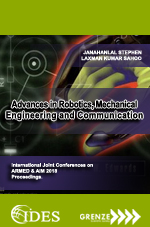Experimental and Numerical Studies to Optimise Turning Process
Conference: Advances in Robotics, Mechanical Engineering and Communication
AbstractIt is well known that the relation between different input process parameters and\nsurface roughness in all machining operations . The same things happen in turning\noperation also. In turning operation, the input parameters like (spindle) speed, feed, depth\nof cut affect the surface finish of the product output. Many engineer and researchers have\ntried to do optimize of this. But still, there is a gap in determining of the exact contribution\nof speed, feed and depth of cut to get optimum surface finish of work piece in turning\noperation.\nTaguchi method is efficient method for designing process that operates consistently and\noptimally over a variety of conditions. Taguchi approach to design of experiments easy to\nadopt and apply for users with limited knowledge of statics, hence gained wide popularity in\nthe engineering and scientific community. The desired cutting parameters determined by\nhandbook. Cutting parameter are reflected on surface roughness,\nGrey relational analysis has been reported efficient in transforming multiple quality\nresponses into a single grade. Several researches have used the grey grade for deciding the\noptimal factor levels. In this context, this work proposes an approach for optimizing\nmultiple quality responses in the Taguchi method using regression models and grey\nrelational analysis; where the former will be used to complete the response values for all\nfactor level combinations, whereas the latter will be used to determine optimal factor levels.\nObjective: It is also well known that surface finish is the one of the output parameters in\nturning operations. So the present work attempts to study the effects of input parameters\nlike speed, feed and depth of cut on the surface finish in turning operation.\nMethodology/approach: This experimental work presents the optimization of turning\nparameters for mild steel bar using the Grey Taguchi Method, A plan of experiments based\non Taguchi’s L9 orthogonal array was established and turning experiments were conducted\nwith prefixed cutting parameters for mild steel bar using tungsten carbide tool. The turning\nparameters are cutting speed, feed rate and depth of cut and the responses are surface finish\n, Taguchi’s signal-to-noise (S/N) ratio are determined based on their performance\ncharacteristics. A grey relational grade, S/N ratio is obtained Based on response value,\noptimum levels of parameters have been identified by using response Table and response\ngraph and the significant contributions of controlling parameters are estimated using\nanalysis of variances (ANOVA).\nResults: In the single response method, percentage contribution of feed rate is most effective\ninput parameters for getting good surface finish. It has been found by using both Taguchi\nand GRA techniques. The best combination (S1-F1-D1) is to get best surface finish output\nresults.\nResearch limitations/implications: Kirby et al. (2004) developed the prediction model for\nsurface roughness in turning operation. The regression model was developed by a single\ncutting parameter and vibrations along three axes were chosen for in-process surface\nroughness prediction system. By using multiple regression and Analysis of Variance\n(ANOVA). |
ARMEC - 2018
|
